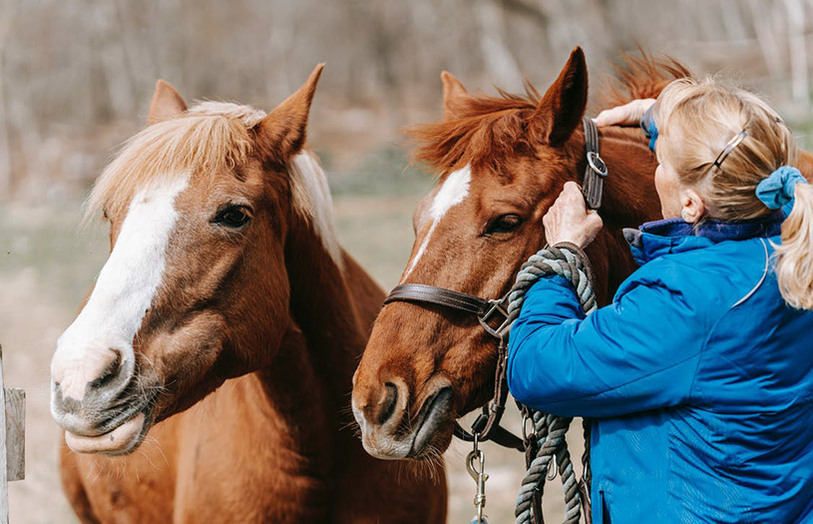
Are You & Your Horse Ready For Bitting Advice? The Steps You Need To Consider First
Equestrian Advice & Guides All Disciplines
Build your business profile for FREE and expose your services to thousands of potential clients!
Create my profile now!
Health and safety must be a primary consideration for all business owners, especially those that own equestrian premises. Not only do you have a duty of care to yourself and your staff, but as a business that is classed as being “open to members of the public” – albeit your riding or livery clients – you must ensure that steps are taken to protect them as well.
One of the easiest ways to understand the health and safety risk is to ensure that your business has a health and safety policy – to set out your general approach to health and safety – as well as undertaking regular risk assessments and fire risk assessments. This will help you identify potential hazards that may cause accidents or injuries on the yard, and plan the action needed to avoid any such issues.
There can be no end to the risks posed on a yard, from slips, trips and falls, to storage areas, machinery, children on the site and even the equines themselves. It is important to fully consider all angles. You need to cover all aspects of your business, from the day-to-day management of equines, to the presence of liveries, clients (and their guests) and any other visitors to the yard, such as those providing professional services, hiring your facilities and attending events. Your risk assessment should include any areas of your premises that are accessible to those on the site at any time.
While the findings of these assessments may flag up some action that needs to be taken directly by yourself, in order to prevent any occurrences, they will also help you devise guidance for anyone using the premises (whether this is your staff, clients or visitors) as to how they can safely work on the yard and with the equines. The outcome of the assessments should help you define the responsibilities and arrangements for health and safety, and this should then be shared with your clients and staff, where appropriate. In the event of any accident or injury that might see a claim on your business insurance, having this documentation can help prove that you have taken necessary steps to identify and avoid hazards, and thus reduce risk. Being able to provide this shows evidence of diligence on your part, to ensure the safety of animals and people on the premises.
Most livery yard owners have never completed any form of risk assessment or even considered their health and safety practices, which goes against the law. The law requires all businesses to have a health and safety policy. If you employ more than 5 members of staff, then this must be a written document which is kept on file. While there is no official requirement for risk assessments themselves to be carried out, every business owner has a legal responsibility to identify the risks, and to take action to eliminate them. A risk assessment is the simplest way to do this.
As best practice, every business should produce a risk assessment and a fire risk assessment, which should be kept on file and be easily accessible so as to ensure they can be supplied on request by insurers, authorities or such like. Completing a risk assessment may seem complicated but it can actually be fairly simple. There are many templated risk assessments available online, however, these are not always current, correct or applicable to your particular business. It is certainly worthwhile finding a specialist equestrian health and safety company, such as Take Up the Reins, who will design a tailored health and safety policy (including risk assessments) for you, and guide you through the completion and how to act on the outcomes. Once you have an initial risk assessment, it can then be easily updated at your chosen frequency (it’s recommended to do this at least once a year, ideally twice).
There may also be other times that you will need to carry out an additional risk assessment. The recent COVID-19 pandemic is a prime example. The pandemic and the restrictions that have been put in place have required business owners to review and update their policies with regards to access, allowance of activities or visitors to the site, and the adherence to cleaning and sanitisation rules. Ideally, all businesses should have issued a specific COVID-19 risk assessment to satisfy themselves that they have identified and taken the necessary steps to protect themselves, their staff and any visitors to the site.
If you have staff, be this employed or freelance, you will also have additional health and safety considerations to ensure that the tasks within their role are undertaken safely, and that they have the correct training and competence to undertake such tasks. By joining an association such as the Equestrian Employers Association (EEA), you’ll have easy access to the necessary tools and guidance, as well as support in the event that any issues may arise. Even better, by joining the ABRS+ as a certified or approved equestrian establishment, you’ll get a complimentary EEA membership included.
Along with other business aspects – such as suitable insurance and adequate training – health and safety policies and risk assessments should be standard ‘good business practice’ and will help prevent injuries or damage, as well as assisting with any insurance claims that may arise. As well as the policy and assessments, health and safety considerations should also include the assurance that you have the correct equipment on site for all to work safely. This could include things like having the correct tools, access and processes for any job that may need to be undertaken, even down to providing a toilet and hand washing facilities. You should ensure that you have the necessary first aid kits on site and that you, ideally, have at least one fully trained first aider on site at all times. If the size of your business warrants it, you should specifically appoint someone to deal with the health and safety of the premises and business, and have a clear process to report any accidents or injuries that may occur.
The Health and Safety Executive (HSE) is the government’s designated health and safety arm, who issue a huge amount of free guidance on all aspects of health and safety, for businesses of all types and sizes. The LiveryList Yard Owner Hub gives a good general overview of health and safety considerations for equestrian premises, including relevant HSE documentation, as well as plenty of other guidance and information on all aspects of the practical and administration side of equestrian establishments.
Below are some links to further documentation providing useful advice and guidance, both on practical health and safety management and on producing the necessary paperwork. Whilst not all directed at equestrian premises, they give good guidance on equestrian safety considerations or those that might apply in a farm or agricultural setting:
CIEH Guidance for Health and Safety in Horse Riding Establishments
British Equestrian Veterinary Associations (BEVA) Managing Risks from Working with Horses
HSE Farmwise Safety in Agricultural Settings
HM Government Fire Safety Risk Assessment: Animal Premises and Stables

